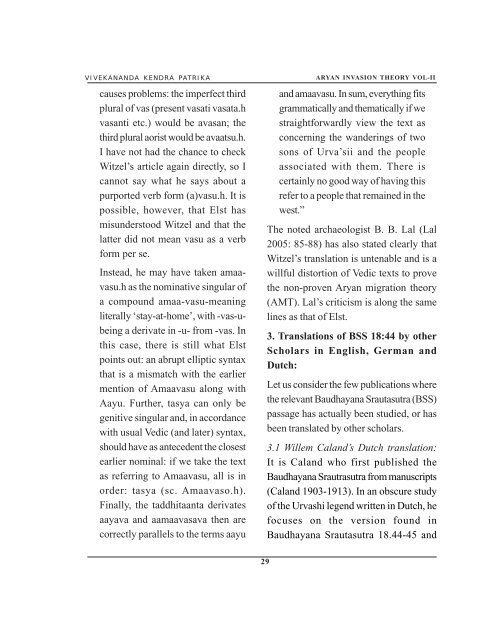Aryan Invasion Theory - Publication - Vivekananda Kendra
Aryan Invasion Theory - Publication - Vivekananda Kendra
Aryan Invasion Theory - Publication - Vivekananda Kendra
Create successful ePaper yourself
Turn your PDF publications into a flip-book with our unique Google optimized e-Paper software.
VIVEKANANDA KENDRA PATRIKA ARYAN INVASION THEORY VOL-II<br />
causes problems: the imperfect third<br />
plural of vas (present vasati vasata.h<br />
vasanti etc.) would be avasan; the<br />
third plural aorist would be avaatsu.h.<br />
I have not had the chance to check<br />
Witzel’s article again directly, so I<br />
cannot say what he says about a<br />
purported verb form (a)vasu.h. It is<br />
possible, however, that Elst has<br />
misunderstood Witzel and that the<br />
latter did not mean vasu as a verb<br />
form per se.<br />
Instead, he may have taken amaavasu.h<br />
as the nominative singular of<br />
a compound amaa-vasu-meaning<br />
literally ‘stay-at-home’, with -vas-ubeing<br />
a derivate in -u- from -vas. In<br />
this case, there is still what Elst<br />
points out: an abrupt elliptic syntax<br />
that is a mismatch with the earlier<br />
mention of Amaavasu along with<br />
Aayu. Further, tasya can only be<br />
genitive singular and, in accordance<br />
with usual Vedic (and later) syntax,<br />
should have as antecedent the closest<br />
earlier nominal: if we take the text<br />
as referring to Amaavasu, all is in<br />
order: tasya (sc. Amaavaso.h).<br />
Finally, the taddhitaanta derivates<br />
aayava and aamaavasava then are<br />
correctly parallels to the terms aayu<br />
29<br />
and amaavasu. In sum, everything fits<br />
grammatically and thematically if we<br />
straightforwardly view the text as<br />
concerning the wanderings of two<br />
sons of Urva’sii and the people<br />
associated with them. There is<br />
certainly no good way of having this<br />
refer to a people that remained in the<br />
west.”<br />
The noted archaeologist B. B. Lal (Lal<br />
2005: 85-88) has also stated clearly that<br />
Witzel’s translation is untenable and is a<br />
willful distortion of Vedic texts to prove<br />
the non-proven <strong>Aryan</strong> migration theory<br />
(AMT). Lal’s criticism is along the same<br />
lines as that of Elst.<br />
3. Translations of BSS 18:44 by other<br />
Scholars in English, German and<br />
Dutch:<br />
Let us consider the few publications where<br />
the relevant Baudhayana Srautasutra (BSS)<br />
passage has actually been studied, or has<br />
been translated by other scholars.<br />
3.1 Willem Caland’s Dutch translation:<br />
It is Caland who first published the<br />
Baudhayana Srautrasutra from manuscripts<br />
(Caland 1903-1913). In an obscure study<br />
of the Urvashi legend written in Dutch, he<br />
focuses on the version found in<br />
Baudhayana Srautasutra 18.44-45 and

















